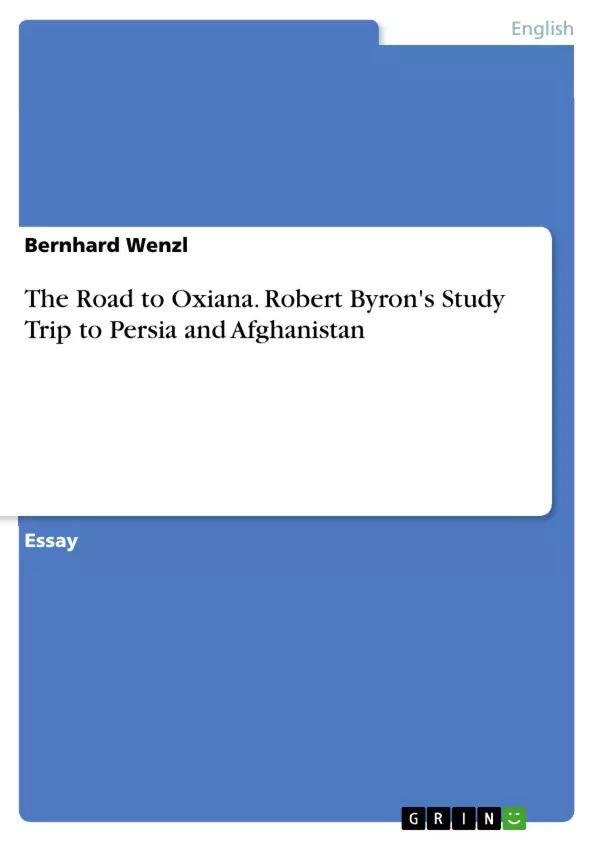This essay deals with Byron's travelogue "The Road to Oxiana". In 1933, Robert Byron sets off for the Middle East to study the Central Asian forms of Islamic buildings and to document architectural masterpieces made of bricks and tiles. The route takes the 28-year-old Englishman by ship, car and horse from Italy and Cyprus via Palestine, Syria and Iraq to Persia and Afghanistan. The destination of his 11-month study trip is Oxiana, a predominantly Turkic-speaking area around the Amu Darya, known as the Oxus in ancient times.
Based on the chronological entries of the travel diary which Byron kept between August 1933 and July 1934, "The Road to Oxiana" (1937) is a literary account in diary form that combines different text types and tones into a multi-layered collage. In addition to narrative passages, it includes numerous political notes, comic dialogues, and sardonic comments, as well as a wealth of architectural, topographical, and ethnological descriptions in exceedingly poetic language.
The travelogue has long since become a classic of modernist British literature. While Bruce Chatwin has referred to it as “a work of genius”, Paul Fussell has attached to it as much importance for the literary canon of the interwar period as James Joyce's novel Ulysses or T.S. Eliot's poem The Waste Land. Even though Robert Byron has sometimes been criticized for his orientalist ideas, he must still be considered a pioneer of contemporary travel literature.
Inhaltsverzeichnis (Table of Contents)
- The Road to Oxiana: Robert Byron’s Travelogue
- From Tehran to Herat
- Modernizing Persia
- Architectural Marvels in Persia
- The Splendour of Isfahan
- Herat's Architectural Heritage
- Afghan Turkestan
- Cultural Encounters
- Mazar-i-Sharif: The Turning Point
- The Buddhas of Bamiyan
- Kabul and Beyond
- The Legacy of The Road to Oxiana
Zielsetzung und Themenschwerpunkte (Objectives and Key Themes)
The Road to Oxiana recounts Robert Byron’s eleven-month study trip through Persia and Afghanistan in the early 1930s. Byron’s main objective was to study the Central Asian forms of Islamic buildings, documenting architectural masterpieces. He aimed to document this architectural legacy and its historical significance, particularly in regions such as Persia and Afghan Turkestan.
- The Impact of Islamic Architecture in Persia and Afghan Turkestan
- The Intersection of History, Architecture, and Culture
- Cultural Encounters and Encounters with Otherness
- The Influence of Modernization on Traditional Societies
- The Role of Travel Writing in Shaping Perceptions of the East
Zusammenfassung der Kapitel (Chapter Summaries)
- The Road to Oxiana: Robert Byron’s Travelogue: Introduces the reader to Robert Byron and his background as a writer and architectural historian. It outlines the purpose and context of his journey to Persia and Afghanistan.
- From Tehran to Herat: This section describes Byron's journey through Persia, starting in Tehran, and his encounters with the architectural legacy of the region, including the Sassanid and Timurid periods. Byron’s observations about the city's modernization efforts and his encounters with the local population are also detailed.
- The Splendour of Isfahan: This chapter focuses on Byron's experience in Isfahan, a city renowned for its Islamic architecture and rich historical heritage. It discusses Byron's admiration for the city's architecture and its cultural significance.
- Herat's Architectural Heritage: Byron's journey takes him to Herat, where he is particularly fascinated by the Musalla, a complex of mosque, madrasah, and mausoleum built under Timurid rule. This section delves into Byron's insights on the city's historical importance and its architectural treasures.
- Afghan Turkestan: This section explores Byron’s travels in Afghan Turkestan, highlighting his observations of cultural differences, the diverse ethnic backgrounds of the region, and his encounters with Uzbek merchants and other ethnic groups.
- Mazar-i-Sharif: The Turning Point: This chapter focuses on Byron's attempts to obtain permission to enter the Soviet Union and visit the Graeco-Bactrian city of Termez. The local authorities’ suspicion of espionage leads to the denial of his request, marking a turning point in his journey.
- The Buddhas of Bamiyan: This section recounts Byron's journey to Bamiyan and his encounter with the Buddha statues, which would later be destroyed by the Taliban. Byron’s impressions of the valley and its historical significance are detailed.
- Kabul and Beyond: Byron’s travels take him to Kabul, where he observes the city’s unique character and its historical and cultural significance. This chapter concludes with Byron’s departure for India and his return to England.
Schlüsselwörter (Keywords)
The Road to Oxiana focuses on the themes of Islamic architecture, cultural encounters, the impact of modernization on traditional societies, and the intersection of history, architecture, and culture. It explores the rich architectural heritage of Persia and Afghan Turkestan, offering insights into the diverse cultures of the region. The travelogue also sheds light on the complex geopolitical landscape of the region in the early 1930s and the role of travel writing in shaping perceptions of the East.
- Quote paper
- Bernhard Wenzl (Author), 2021, The Road to Oxiana. Robert Byron's Study Trip to Persia and Afghanistan, Munich, GRIN Verlag, https://www.grin.com/document/1171524



